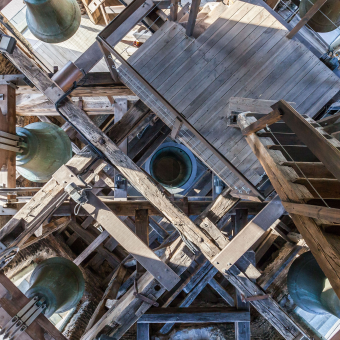

The decoration of the chapel’s dome refers to Casimir’s piety and virtue. Sculptures symbolising temperance, justice, fortitude and prudence stand in the niches between the windows.
The virtue of Justice is represented by a woman holding a pair of scales, a symbol of fairness and impartiality, in her right hand. In her left hand, she holds a sword to protect the righteous and punish the guilty. Next to her is an ostrich, a symbol of justice. It was believed that this bird can digest iron, and all its feathers are of equal length.
The virtue of Fortitude is symbolised by an armour-clad woman. In her right hand, she is holding an oak staff, showing strength of spirit; and with her left hand she is leaning on a column, signifying constancy. Next to her is a lion, a symbol of wisdom and power.
The figure depicting the virtue of Prudence is holding a mirror, a symbol of self-knowledge. In her right hand she is holding a fish, referring to well-judged, prudent actions. Next to her is an elk, which was considered a wise animal, for even when running swiftly it does not get caught up in shrubbery.
The figure representing the virtue of Temperance is diluting wine with water. An elephant standing nearby also embodies moderation. It was believed that this animal never eats more than necessary, and puts aside the rest for the next day.
There are four painted compositions in the dome’s pendentives: Chastity and Virtue above the entrance (by Franciszek Smuglewicz), and St Casimir’s Hymn to the Blessed Virgin Mary and St Casimir Accompanied to Heaven above the altar (by Michelangelo Palloni). At the apex of the dome is a dove, a symbol of the Holy Spirit.




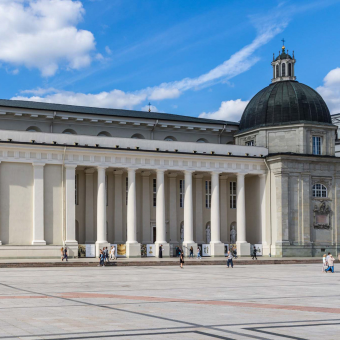




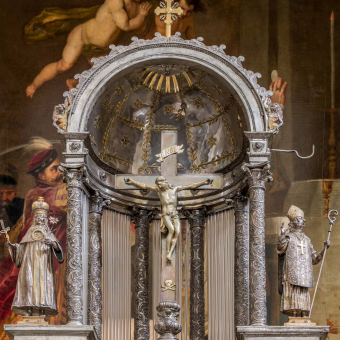
The altarpiece of the Cathedral Basilica’s main altar has three parts. The first, somewhat higher up than the others, bears a symbol of Divine Providence, above which there rises a cross with the figure of Christ. The second part features an elaborate tabernacle.
A tabernacle is an ornate box meant to hold the Most Blessed Sacrament. The Cathedral tabernacle was decorated with the scenes portraying the events of Holy Thursday: the Last Supper, Jesus washing the feet of his disciples, and his prayer in the Garden of Olives. Above the tabernacle there is a domed niche for a cross or a monstrance, beside which there are the statues of St. Casimir and St. Stanislaus – the patron saints of Lithuania and the diocese of Vilnius.
The new altar, where Holy Mass is now celebrated, was installed in 2007 in line with the indications of Vatican Council II.


The paintings of the Twelve Apostles on the pillars of the central nave are by Franciszek Smuglewicz.
The artist Costantino Villani was invited from Italy to create 16 large paintings specifically for the cathedral. It is the most spectacular series of paintings on themes from Holy Scripture in Lithuania.
Facing the altar, scenes from the New Testament are depicted on the left side, and scenes from the Old Testament are depicted on the right.
On the right side, eight paintings representing stories from the Old Testament hang on the walls above the chapels between the pilasters. Walking from St Casimir’s Chapel towards the organ loft, they are: The Creation, Cain and Abel, Abraham’s Sacrifice of Isaac, Jacob’s Dream, Joseph in Prison, Moses at Mount Sinai, Joshua’s Victory and The Judgement of Solomon.
There are another eight paintings by Costantino Villani on the left side. Walking from the sacristy towards the organ loft, they are: The Annunciation by the Archangel Gabriel, The Nativity of Christ, The Massacre of the Innocents, The Adoration of the Magi, The Flight into Egypt, The Baptism of Christ, Jesus is Laid in the Tomb and The Descent of the Holy Spirit.







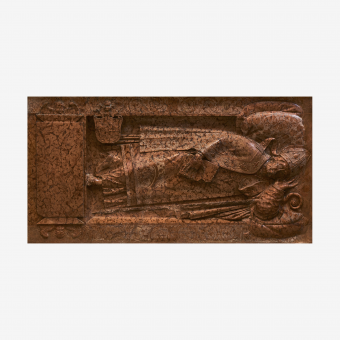
Built in the 15th century, the chapel belonged to the Goštautas (Gasztold) noble family, who are buried in the crypt below.
Two valuable 16th century tombstones have survived in the east and west walls of the chapel. The first is dedicated to Albertus Goštautas, the chancellor of the Grand Duchy of Lithuania (by Bernardo Zanobi da Gianotti). This is the oldest memorial sculpture in Lithuania. The influence of both Gothic and Renaissance art forms are obvious. The second tombstone is dedicated to Bishop Paulius (Povilas) Alšėniškis (Pawel Holszański) (by Giovanni Maria Padovano).

The highlight of the chapel is the painting "Our Lady of St Michael", which is more usually called "The Madonna of the Sapiehas". This image of the Blessed Virgin Mary with the Franciscan saints Francis and Bernardine has been famous for its miracles since the 16th century. Formerly kept in the Bernardine Church, the painting later belonged to the Bernardine convent’s Church of St Michael the Archangel. The name "The Madonna of the Sapiehas" refers to the name of the family who endowed the convent. Miracles worked in the presence of the painting were recorded, and on 8 September 1750 the image was decorated with crowns sent by Pope Benedict XIV (the frame and the crowns have not survived). It was the fourth holy image in the Grand Duchy of Lithuania to be crowned (and the second oldest in Lithuania today).
In 2020, through the efforts of the Cathedral community, the crowns of Our Lady and Infant Jesus were restored and adorn the painting again.

Since 1989 this chapel has been dedicated to the memory of the killed, imprisoned or exiled during the Soviet era. The chapel has three inscriptions commemorating Bishops of Vilnius: Bishop Jan Nepomucen Kossakowski (1755–1808), Bishop Mečislovas Reinys (1884–1953), and Bishop Julijonas Steponavičius (1911–1991).The niches in the walls contain eight sculptures of saints, above which little angels hold symbols of the virtues (work of Pranciškus Smuglevičius). The sculpture of the Crucified Christ was transferred to the chapel from the Church of the Trinitarians, which was closed in 1864.
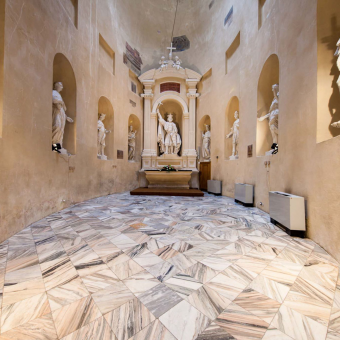
St Vladislaus was the king of Hungary and Croatia who lived in the 11th century and became the patron saint of Hungary. Jogaila, the ruler of Lithuania and Poland, chose Vladislaus as his baptismal name. That is why when Jogaila built Vilnius Cathedral in 1387 it was decided to name it after both St Stanislaus and St Vladislaus.
Wawrzyniec Gucewicz designed the elliptical Chapel of St Ladislaus (formerly the Chapel of Bishop Abraham Woyna) in the last major remodelling of the cathedral. It used to have mural paintings, of which only fragments can be seen today. The Latin inscriptions that have survived beside the chapel’s altar reveal the theological meaning of the paintings: Zelus (zeal) and Fides (faith). The altar was built in the mid-19th century, and the niche holds a massive plaster sculpture of St Ladislaus holding a cross (1861–1863, by the sculptor Henryk Dmochowski). Until 1905, this sculpture was covered up, by order of the Imperial Russian authorities, as a manifestation of active Catholic missionary work. The chapel’s Latin dedication can be seen in the fresco above the statue of King Ladislaus.
At Christmas, a nativity scene is displayed in the Chapel of St Ladislaus, and a procession with the Blessed Sacrament is conducted to the chapel on Maundy Thursday.



The Royal, or Wołłowicz, Chapel was built in the late 15th century by the King of Poland and Grand Duke of Lithuania Casimir Jagiellon. The crypt of this chapel became the burial place for members of the royal family, including the famously pious Prince Casimir.
When the Church allowed the veneration of St Casimir, Sigismund III Vasa, the ruler of Lithuania and Poland, began to build a new Chapel of St Casimir in the southeast corner, on the site of the former chapel maintained by the Bishop of Vilnius Eustachius Wołłowicz (1572–1630). The two chapels swapped places, and the Royal Chapel became the Wołłowicz Chapel. The chapel was built and decorated by Eustachius Wołłowicz before 1630.
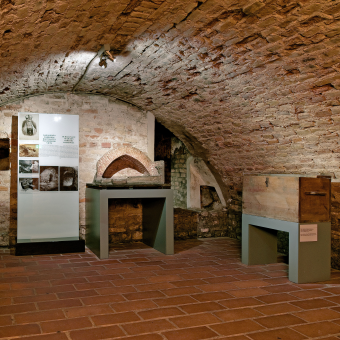
For many centuries the crypts beneath the cathedral were used to bury prominent nobility, rulers, bishops and Chapter members of the Grand Duchy of Lithuania. The most famous of them were Vytautas the Great, Alexander I Jagiellon, and Barbara Radziwiłł. The historic walls of the Cathedral, crypts, and one of the oldest frescos in Lithuania can be seen in the underground exhibition.


Vytautas was the first ruler of Lithuania to be buried in Vilnius Cathedral. He contributed to the reconstruction and decoration of the church.1930 was the year when 500 years since Vytautas death was commemorated. It was hoped that by the time the remains of the grand duke would be recovered and transferred into the newly made sarcophagus. In fact, though, the search for Vytautas remains has not stopped yet.
Sarcophagus for the remains of Vytautas the Great. Czechoslovakia, 1930. National Museum of Lithuania



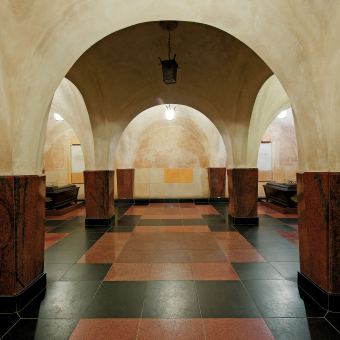

Since 2019, new routes are open to visitors at the crypts of Vilnius Cathedral in the northern part of the cathedral provide an opportunity for visitors to learn about and see spaces that for years had been literally inaccessible, bricked up and closed off. Visitors taking the extreme tour will be able to see some of the oldest masonry in Lithuania, remains of a 13th-14th century tower and staircase, invaluable historic masonry of Jogaila and Vytautas’s cathedral, crypts and mausoleum that harken back to numerous different burial customs, walls that evidence the cathedral’s reconstruction, , an 18th century drainage system, Gothic bricks and other valuable items arranged over a rather large area of 120 square meters under Vilnius Cathedral.

The Bell Tower is an important part of the complex comprising Vilnius Cathedral Basilica and the Lower and Upper Castles and the symbol of the city. The history of Bell Tower dates back to the middle of the 13th century. It acquired its current appearance in the early 19th century. The oldest clock in the city shows time in the upper part of the structure; the tolling of the bells invite people to Holy Mass, and an unexpected panoramic view of Vilnius opens out.
During the Soviet times a decision was made to install a carillon in the Cathedral Bell Tower. Bells of various sizes were brought here from closed churches in Lithuania. But despite drilling, milling and grinding, the efforts to tune the bells failed. In 2009 they were restored in the workshop of the Archdiocese of Cologne. Some of the bells have been returned to the churches from which they were taken, others are on display in the Bell Tower.
